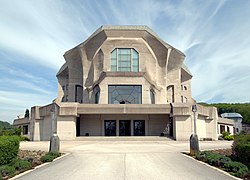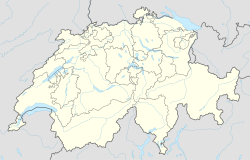인지학의 슈타이너, 그의 기이한 건축 괴테아눔
8 Dec 2023(2)
by시몽Sep 13. 2024
Goetheanum 괴테아눔을 보러 도나흐라는 먼 지역까지. 건물 하나만 건축이 기이한 게 아니고 그 동네 주변 건물들이 다 이렇다.
괴테아눔

| 인지학 |
|---|
| 일반 |
| 인지학 · 루돌프 슈타이너 인지학적 사회 · 괴테아눔 |
| 영향 |
| 캠프힐 운동 · 오이리트미 |
| 철학 |
| 자유 철학 |
| 사회학 |
| 사회적 삼중론 |
괴테아눔(Goetheanum)은 인지학 운동의 세계적인 중심지이다. 스위스 졸로투른주의 도르나흐에 위치해 있다.
건물은 루돌프 슈타이너가 설계했으며 요한 볼프강 폰 괴테의 이름을 따서 명명되었다.[1] 여기에는 2개의 공연장(1500석), 갤러리 및 강의 공간, 도서관, 서점, 인지학 협회의 행정 공간이 포함되어 있다. 인근 건물에는 사회의 연구 및 교육 시설이 있다. 일반적인 관심 주제에 초점을 맞추거나 교사, 농부, 의사, 치료사 및 기타 전문가를 대상으로 하는 컨퍼런스가 연중 내내 센터에서 열린다.
괴테아눔은 일주일 내내 방문객에게 개방되며 매일 여러 차례 투어를 제공한다.
각주
- Sokolina, Anna P. "Biology in Architecture: the Goetheanum Case Study." In: The Routledge Companion to Biology in Art and Architecture, edited by Charissa Terranova and Meredith Tromble, 52-70. New York and London: Routledge, 2016. 546p.
외부 링크
- 괴테아눔 - 공식 웹사이트
- Goetheanum 3D VRML Models by Horst Kiechle
- The First Goetheanum at the Great buildings online website
- Architecture Section at the Rudolf Steiner Archive, An Online Library
- Architecture and Anthroposophy. (Arkhitektura i Antroposofiia. bilingual ed.) Anna Sokolina, ed., co-author. 1st and 2nd edition. 268p. M.: KMK Scientific Press. 2001, ISBN 5-87317-074-6. 2010, ISBN 5-87317-660-4. Official book website.
- Ákos Moravánszky, "The Rudolf Steiner Goetheanum: An architecture report from Dornach", Domus, February 2011
Goetheanum
| Goetheanum | |
|---|---|
 | |
| General information | |
| Town or city | Dornach |
| Country | Switzerland |
| Coordinates | 47°29′10″N 7°37′13″E |
The Goetheanum, located in Dornach, in the canton of Solothurn, Switzerland, is the world center for the anthroposophical movement. The term refers to two structures, the first was in use 1919 to 1922 and destroyed by fire; the second was completed in 1928 and is in use since.
The building was designed by Rudolf Steiner and named after Johann Wolfgang von Goethe.[1] It includes two performance halls (1500 seats), gallery and lecture spaces, a library, a bookstore, and administrative spaces for the Anthroposophical Society; neighboring buildings house the society's research and educational facilities. Conferences focusing on themes of general interest or directed toward teachers, farmers, doctors, therapists, and other professionals are held at the center throughout the year.
The Goetheanum is open for visitors seven days a week and offers tours several times daily.
| Part of a series onAnthroposophy GeneralAnthroposophy Rudolf Steiner Ita Wegman Anthroposophical Society GoetheanumAnthroposophically inspired work Waldorf education Biodynamic agriculture Anthroposophic medicine Camphill Movement EurythmyThe Christian Community Philosophy Social threefolding |
First Goetheanum

The First Goetheanum, a timber and concrete structure designed by Rudolf Steiner,[2][3] was one of seventeen buildings Steiner designed between 1908 and 1925.[4] It was intended as a Gesamtkunstwerk (the synthesis of diverse artistic media and sensory effects)[5] infused with spiritual significance.[6] Begun in 1913 to house the annual summer theater events of the Anthroposophical Society,[7] it rapidly became the center of a small colony of spiritual seekers located in Dornach and based around Steiner.[8] Numerous visual artists contributed to the building: architects created the unusual double-dome wooden structure over a curving concrete base, stained glass windows added color into the space, painters decorated the ceiling with motifs depicting the whole of human evolution, and sculptors carved huge column bases, capitals, and architraves with images of metamorphoses.[4][9]
Already during the construction, musicians, actors, and movement artists began performing a wide variety of pieces in a neighboring workshop. When the Goetheanum hall was completed, in 1919, these performances moved onto the stage located under the Goetheanum's smaller cupola. The auditorium was located under the larger cupola. The building was opened on September 26, 1920.[10]
This building was destroyed by fire on New Year's Eve, December 31, 1922 – January 1, 1923, and some claim by arson,[9][11] but that is not proven.[10]
Second Goetheanum






In the course of 1923, Steiner designed a building to replace the original. This building, now known as the Second Goetheanum, was built wholly of cast concrete.[12] Begun in 1924, the building was not completed until 1928,[7] after the architect's death. It represents a pioneering use of visible concrete in architecture[13] and has been granted protected status as a Swiss national monument.[14] Art critic Michael Brennan has called the building a "true masterpiece of 20th-century expressionist architecture".[15]
The present Goetheanum houses a 1000-seat auditorium, now the center of an active artistic community incorporating performances of its in-house theater and eurythmy troupes as well as visiting performers from around the world. Full remodelings of the central auditorium took place in the mid-1950s and again in the late 1990s. The stained glass windows in the present building date from Steiner's time; the painted ceiling and sculptural columns are contemporary replications or reinterpretations of those in the First Goetheanum.
In a dedicated gallery, the building also houses a nine-meter-high wooden sculpture, The Representative of Humanity, by Edith Maryon and Rudolf Steiner.[16]
Architectural principles
Steiner's architecture is characterized by a liberation from traditional architectural constraints, especially through the departure from the right-angle as a basis for the building plan. For the first Goetheanum he achieved this in wood by employing boat builders to construct its rounded forms; for the second Goetheanum by using concrete to achieve sculptural shapes on an architectural scale.[17] The use of concrete to achieve organically expressive forms was an innovation for the times; in both buildings, Steiner sought to create forms that were spiritually expressive.[18]
Steiner suggested that he had derived the sculptural forms of the first Goetheanum from spiritual inspirations.[19]
Architects who have visited and praised the Goetheanum's architecture include Henry van de Velde, Frank Lloyd Wright, Hans Scharoun, and Frank Gehry.[20]
Steiner designed approximately 12-13 other built structures, including both institutional structures and residences in and around Dornach.[18]
References
- Sokolina, Anna P. "Biology in Architecture: the Goetheanum Case Study." In: The Routledge Companion to Biology in Art and Architecture, edited by Charissa Terranova and Meredith Tromble, 52-70. New York and London: Routledge, 2016; 2019. 546p.
- Patrice Goulet, "Les Temps Modernes?", L'Architecture D'Aujourd'hui, Dec. 1982, pp. 8-17.
- Goetheanum I in The Great Buildings Collection, compiled by ArchitectureWeek. Great buildings online listing
- David Adams, "Rudolf Steiner's First Goetheanum as an Illustration of Organic Functionalism", The Journal of the Society of Architectural Historians, 51(2), 182–204, June 1992. Abstract
- Sokolina, Anna. "Modernist Topologies: The Goetheanum in Building." In Modernity and Construction of Sacred Space, edited by Aaron French and Katharina Waldner, 149–168. Berlin: De Gruyter Oldenbourg, 2024. ISBN 9783111061382 and 9783111062624. https://doi.org/10.1515/9783111062624-008.
- Eugene Santomasso, Origins and Aims of German Expressionist Architecture: An essay into the expressionist frame of mind in Germany, especially as typified in the work of Rudolf Steiner, Ph.D. dissertation, Columbia University, 1973, AAT 7616368. Dissertation extract Archived 2007-12-14 at the Wayback Machine
- Beate Steinberg, Sculptural Architecture: Rudolf Steiner's Goetheanum at Dornach, from wood to concrete, Master's thesis, California State University, 1976, AAT 1308149.
- Anna Sokolina, ed., co-author, Architecture and Anthroposophy, "Part One: Origins", "Part Two: New Impulses", 1st and 2nd edition, M: KMK, 2001, 2010. 268p. 348 ills. 2001 ISBN 587317-0746, 2010 ISBN 587317-6604.
- Bernadette (Becky) Schwarz, A Study of Rudolf Steiner's First Goetheanum, M.A. thesis, Michigan State University, 1983.
- Paull, John (2020). The First Goetheanum: A Centenary for Organic Architecture, Journal of Fine Arts. 3 (2): 1-11
- "Home of Theosophy Burns", The New York Times, Jan 2, 1923.
- Sokolina, Anna P. "The Goetheanum Culture in Modern Architecture." [Kultura Geteanuma v sovremennoi architecture.] Science, Education and Experimental Design [Nauka, obrazovaniie i eksperimental'noie proiektirovaniie. Trudy MARKHI], edited by Shvidkovsky D.O., G.V. Yesaulov, et al., 157-159. Moscow: MARKHI, 2014. 536p.
- Dornach in German, French and Italian in the online Historical Dictionary of Switzerland.
- Hans Hasler, "A sculptural expression of harmony", Architects' Journal , S9(3), March 4, 1999.
- Michael Brennan, Rudolf Steiner, artnet Magazine 3/18/98
- Paull, John (2018) A Portrait of Edith Maryon: Artist and Anthroposophist, Journal of Fine Arts, 1(2):8-15.
- Richard Reid, The book of buildings: Ancient, medieval, Renaissance & modern architecture of North America & Europe, ISBN 0-442-27805-5. Chapter title "Modern Architecture", subsection "Switzerland".
- Werner Blaser, Nature in Buildings: Rudolf Steiner in Dornach 1913-1925, ISBN 3-7643-6541-2
- Rudolf Steiner, Ways to a New Style in Architecture, five lectures given at Dornach, Switzerland during the building of the First Goetheanum, 1914. Also published as Architecture as a Synthesis of the Arts, 1999, ISBN 1-85584-057-X
- Reinhold Johann Fäth, Rudolf Steiner Design – Spiritueller Funktionalismus Kunst, Diss. University of Konstanz (2004) (as PDF Archived 2005-05-23 at the Wayback Machine)
External links
- Official website
- Goetheanum 3D VRML Models by Horst Kiechle
- The First Goetheanum at the Great buildings online website
- Architecture Section at the Rudolf Steiner Archive, An Online Library
- Architecture and Anthroposophy. (Arkhitektura i Antroposofiia. bilingual ed.) Anna Sokolina, ed., co-author. 1st and 2nd edition. 268p. M.: KMK Scientific Press. 2001, ISBN 5-87317-074-6. 2010, ISBN 5-87317-660-4. Official book website.
- Ákos Moravánszky, "The Rudolf Steiner Goetheanum: An architecture report from Dornach", Domus, February 2011
- Buildings and structures in the canton of Solothurn
- Monuments and memorials in Switzerland
- Expressionist architecture
- Organic architecture
- Architecture in Switzerland
- Buildings and structures completed in 1919
- Buildings and structures completed in 1928
- Rudolf Steiner
- Johann Wolfgang von Goethe
- Anthroposophy
- Tourist attractions in the canton of Solothurn
- Art Nouveau architecture in Switzerland
- Art Nouveau theatres
- 20th-century architecture in Switzerland
인지학
| 인지학 |
|---|
| 일반 |
| 인지학 · 루돌프 슈타이너 인지학적 사회 · 괴테아눔 |
| 영향 |
| 캠프힐 운동 · 오이리트미 |
| 철학 |
| 자유 철학 |
| 사회학 |
| 사회적 삼중론 |
인지학(人智學, 독일어: anthroposophie, 영어: anthroposophy)은 오스트리아인 학자 루돌프 슈타이너가 설립한 철학으로, 루돌프가 자신의 사상을 가리켜 사용한 용어이다. 지각적 체험과는 관계 없는 일종의 사고를 배양함으로써, 인지적 상상, 영감적 고취, 직관의 능력들을 계발하는 것이 목표이다.[1][2]
같이 보기
각주
- Robert McDermott, The Essential Steiner, ISBN 0-06-065345-0, pp. 3–11, 392–5
- "Anthroposophy", Encyclopædia Britannica online, accessed 10/09/07
외부 링크
- (영어) Rudolf Steiner Archive (Steiner's works online)
- (영어) Steiner's complete works in German
- (영어) Rudolf Steiner Handbook (PDF, 56 MB)
- (한국어) 한국 루돌프 슈타이너 인지학 연구 센터 보관됨 2005-08-28 - 웨이백 머신



